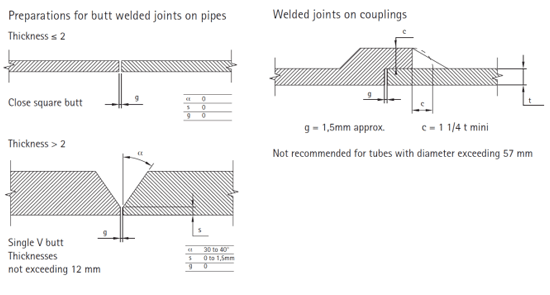Top Cupronickel Pipes and Fittings Manufacturer & Exporter
Providing that certain precautions are taken, and welding does not present major difficulty. Inert shielded arc processes (TIG) are particularly appropriate to the welding of these alloys.
The following procedure has been established for assemblies in tubes and accessories with a thickness of 1.5 to 10 mm welded by the TIG process.
To weld under proper working conditions, the welding set should be equipped with a pre-gas, pre-arc, and arc fall system.
Its state of cleanliness is most important, influencing the quality of the weld and the stability of the arc.
The diameter of the electrode is dependent on the welding current:
| Diameter mm | Current mm |
|---|---|
| 1 | 25/70 |
| 1.6 | 60/150 |
| 2 | 100/200 |
| 3 | 200/300 |
To achieve a perfectly stable arc and obtain a maximum heat concentration it is advisable to work the electrode as close as possible to the maximum supportable current.
Protective gas : neutral argon protection is generally sufficient. Torch flow 8 to 12 l/mn.
Specifications for filler metal are:
Aws specification: A.5.7.ERCuNi BS EN ISO 24373
Cu630% Ni filler metal is recommended for both alloys.
The parent metal filler rods should always be perfectly degreased.
In general, all types of joints can be used.
For tubes and accessories with a thickness less than or equal to 2 mm, it is not necessary to make a chamfer but it is desirable to break the internal square corner to favor penetration.
For tubes and accessories with a thickness greater than 2 mm, a chamfer of around 30° to 40° is recommended.

We are one of the prominent manufacturer and supplier of cupronickel products in India. We have achieved this by consistently upholding our highest ethical standards, integrity, and values in the market from last two decades.